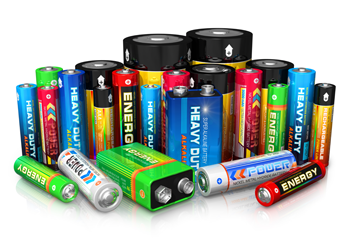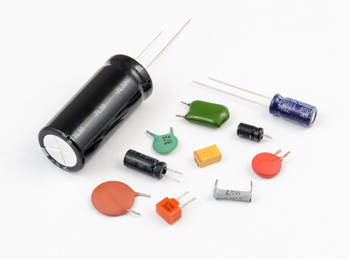What Does A Capacitor Store
Energy tin exist stored in a diverseness of means. When you lot pull back on a slingshot, energy from your muscles is stored in its elastic bands. When you wind upward a toy, energy gets stored in its spring. Water held backside a dam is, in a sense, stored energy. As that water flows downhill, it can power a water wheel. Or, information technology can motility through a turbine to generate electricity.
When information technology comes to circuits and electronic devices, free energy is typically stored in one of two places. The first, a bombardment, stores energy in chemicals. Capacitors are a less common (and probably less familiar) alternative. They shop free energy in an electric field.
In either case, the stored energy creates an electric potential. (One mutual name for that potential is voltage.) Electrical potential, as the proper name might suggest, can bulldoze a catamenia of electrons. Such a menstruum is chosen an electric electric current. That current can be used to power electrical components inside a circuit.
These circuits are found in a growing multifariousness of everyday things, from smartphones to cars to toys. Engineers choose to use a battery or capacitor based on the circuit they're designing and what they desire that item to do. They may even use a combination of batteries and capacitors. The devices are not totally interchangeable, nonetheless. Hither's why.
Batteries
Batteries come in many different sizes. Some of the tiniest power small devices like hearing aids. Slightly larger ones get into watches and calculators. All the same larger ones run flashlights, laptops and vehicles. Some, such as those used in smartphones, are specially designed to fit into only one specific device. Others, like AAA and ix-volt batteries, can ability any of a broad variety of items. Some batteries are designed to be discarded the first time they lose ability. Others are rechargeable and can discharge many, many times.

A typical battery consists of a example and three primary components. Two are electrodes. The tertiary is an electrolyte. This is a gooey paste or liquid that fills the gap betwixt the electrodes.
The electrolyte can be made from a variety of substances. But whatever its recipe, that substance must be able to conduct ions — charged atoms or molecules — without allowing electrons to pass. That forces electrons to exit the battery via terminals that connect the electrodes to a excursion.
When the circuit isn't turned on, the electrons can't move. This keeps chemical reactions from taking place on the electrodes. That, in turn, enables free energy to exist stored until it is needed.
The battery's negative electrode is called the anode (ANN-ode). When a bombardment is connected into a live circuit (i that has been turned on), chemic reactions take place on the anode'due south surface. In those reactions, neutral metallic atoms give up one or more electrons. That turns them into positively charged atoms, or ions. Electrons flow out of the bombardment to do their work in the circuit. Meanwhile, the metal ions flow through the electrolyte to the positive electrode, called a cathode (KATH-ode). At the cathode, metallic ions gain electrons as they menses back into the battery. This allows the metal ions to become electrically neutral (uncharged) atoms one time again.
The anode and cathode are commonly fabricated of different materials. Typically, the anode contains a material that gives up electrons very hands, such as lithium. Graphite, a course of carbon, holds onto electrons very strongly. This makes it a proficient material for a cathode. Why? The bigger the departure in the electron-gripping beliefs between a bombardment'south anode and cathode, the more energy a battery tin hold (and later share).
As smaller and smaller products accept evolved, engineers have sought to make smaller, yet still powerful batteries. And that has meant packing more free energy into smaller spaces. Ane mensurate of this trend is energy density. That'south calculated by dividing the corporeality of free energy stored in the battery by the battery's book. A bombardment with loftier free energy density helps to make electronic devices lighter and easier to carry. Information technology also helps them last longer on a single charge.

In some cases, however, high energy density tin can also brand devices more unsafe. News reports take highlighted a few examples. Some smartphones, for instance, accept caught fire. On occasion, electronic cigarettes accept blown up. Exploding batteries have been behind many of these events. Most batteries are perfectly safe. But sometimes there may be internal defects that cause energy to be released explosively inside the battery. The same destructive results can occur if a battery is overcharged. This is why engineers must be careful to pattern circuits that protect batteries. In item, batteries must operate only within the range of voltages and currents for which they accept been designed.
Over time, batteries can lose their ability to hold a charge. This happens even with some rechargeable batteries. Researchers are always looking for new designs to address this problem. But one time a bombardment can't be used, people usually discard it and purchase a new ane. Because some batteries contain chemicals that aren't eco-friendly, they must be recycled. This is 1 reasons engineers have been looking for other ways to store free energy. In many cases, they've begun looking at capacitors.
Capacitors
Capacitors can serve a variety of functions. In a circuit, they can block the flow of direct electric current (a one-directional flow of electrons) simply allow alternating current to laissez passer. (Alternate currents, similar those obtained from household electrical outlets, reverse direction many times each second.) In sure circuits, capacitors help tune a radio to a detail frequency. Just more and more, engineers are besides looking to use capacitors to store free energy.
Capacitors have a pretty basic design. The simplest ones are made from two components that tin can conduct electricity, which nosotros'll call the conductors. A gap that doesn't comport electricity ordinarily separates these conductors. When connected to a alive circuit, electrons flow in and out of the capacitor. Those electrons, which have a negative charge, are stored on one of the capacitor'south conductors. Electrons won't flow across the gap betwixt them. Still, the electric accuse that builds upwards on one side of the gap affects the accuse on the other side. Nevertheless throughout, a capacitor remains electrically neutral. In other words, the conductors on each side of the gap develop equal only opposite charges (negative or positive).

The amount of energy a capacitor can shop depends on several factors. The larger the surface of each usher, the more charge it tin can store. Also, the ameliorate the insulator in the gap between the 2 conductors, the more charge that can be stored.
In some early on capacitor designs, the conductors were metallic plates or disks separated by zippo but air. Merely those early on designs couldn't concord as much energy as engineers would have liked. In later designs, they began to add non-conducting materials in the gap between the conducting plates. Early examples of those materials included glass or paper. Sometimes a mineral known as mica (MY-kah) was used. Today, designers may choose ceramics or plastics as their nonconductors.
Advantages and disadvantages
A battery tin store thousands of times more free energy than a capacitor having the same volume. Batteries besides tin supply that free energy in a steady, undecayed stream. But sometimes they tin't provide free energy as quickly every bit it is needed.
Take, for example, the flashbulb in a camera. It needs a lot of energy in a very short time to brand a bright flash of light. So instead of a battery, the circuit in a wink attachment uses a capacitor to store energy. That capacitor gets its energy from batteries in a irksome but steady period. When the capacitor is fully charged, the flashbulb's "ready" lite comes on. When a picture is taken, that capacitor releases its energy quickly. Then, the capacitor begins to charge up again.
Since capacitors shop their energy as an electrical field rather than in chemicals that undergo reactions, they tin be recharged over and over once again. They don't lose the capacity to hold a charge as batteries tend to do. Also, the materials used to brand a simple capacitor usually aren't toxic. That means nigh capacitors can be tossed into the trash when the devices they power are discarded.
The hybrid
In recent years, engineers have come with a component called a supercapacitor. It's not merely some capacitor that is actually, actually good. Rather, it'due south sort of somehybrid of capacitor and battery.
So, how does a supercapacitor differ from a bombardment? The supercapacitor has two conducting surfaces, like a capacitor. They're called electrodes, every bit in batteries. But unlike a battery, the supercapacitor stores energy on the surface of each of these electrodes (every bit a capacitor would), not in chemicals.
Meanwhile, a capacitor normally has a non-conducting gap between two conductors. In a supercapacitor, this gap is filled with an electrolyte. That would be like to the gap betwixt the electrodes in a battery.
Supercapacitors can shop more energy than regular capacitors. Why? Their electrodes accept a very large surface expanse. (And the larger the surface expanse, the more electric charge they can hold.) Engineers create a large expanse by coating the electrode with a very big number of very tiny particles. Together, the particles produce a rugged surface that has much more than area than a apartment plate would. That lets this surface shop far more energy than a regular capacitor can. Withal, supercapacitors tin can't match the energy density of a battery.
CORRECTION: This story has been revised to right i sentence that had inadvertently switched the term cathode for anode. The story now reads correctly.
More Stories from Science News Explores on Physics
What Does A Capacitor Store,
Source: https://www.snexplores.org/article/explainer-batteries-capacitors
Posted by: borismoseect1983.blogspot.com



0 Response to "What Does A Capacitor Store"
Post a Comment